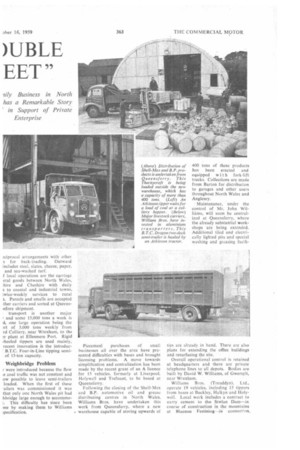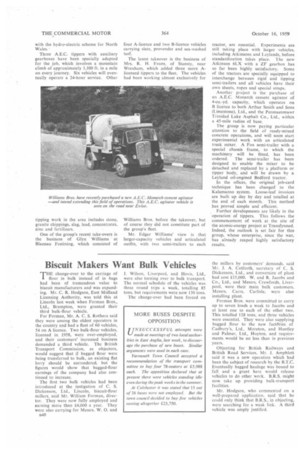" WE'Ll THE
Page 72

Page 73

Page 74

If you've noticed an error in this article please click here to report it so we can fix it.
By
G. Duncan Jewell ONE of the major transport links between the North Wales counties of Flint, Denbigh, Caernarvon and Anglesey and the rest of Great Britain is provided by the Williams Bros. group of haulage companies, with main bases at Queensferry, Denbigh and Treuddyn.
The business—started by Mr. E. L. Williams in the 1920s—is still a family affair, carried on by his four sons and a son-in-law, with Mr. Edgar Williams as managing director. During nationalization the family operated 25 vehicles— mainly tippers—on local work between Flintshire and the Liverpool area. However, at the end of this period it was realized that, to safeguard existing goodwill, it would be necessary to undertake long-distance work for established customers, and the bold decision to double the fleet size was made.
Rapid Growth
By 1954 seven special A vehicles had been assigned to them, and in the same year the 18-vehicle fleet of Brooke Bros., Rhyl, was acquired. This was followed by the take-over of three A-licence vehicles—two from Chas. Griffiths, Liverpool, and one from W. Roberts, Trefnant.
A shortage of livestock vehicles in Denbighshire at the time prompted the conversion of three A-licence vehicles for this traffic. The business grew so rapidly that between August, 1954, and February, 1955, they were used almost exclusively to carry livestock.
However, this work was outside their normal-user conditions and it led to complications with the Licensing Authority. Despite these difficulties it was necessary to meet customers' requirements and, as a result, special A vehicles were employed on livestock work until it became possible to consolidate the position by acquiring the three livestock vehicles of J. M. Stevenson, Mynydd Isa, and two more from T. L. Parry, Corwen.
By May, 1957, this branch of the business justified a depot of its own and when the premises and nine-vehicle fleet of Abel Roberts, at Denbigh, came on the market, no time was lost in purchasing it. A later acquisition was another three vehicles from Gwynn Thomas, Trefnant.
As a result of this development, Williams Bros. (Denbigh), Ltd., have become the major livestock hauliers for Flint, Denbigh and part of Merioneth, with greater efficiency coming from the co-ordination of a number of small businesses as a unit. Aluminium containers, made to the company's own specification, have eliminated criticisms from farmers and animal-lovers concerning the welfare of animals in transit.
New vehicles include an A.E.C. threedeck six-wheeler, capable of carrying 450 sheep or 37 cattle, and B.T.C. Dragon two-deck trailers, 28 ft. long, with capacity for 18 cattle or 350 sheep, drawn by Bedford tractors. These trailers offer improved platform height, easier loading and better manauvrability. New loading bays at St. Asaph Market, which enable four vehicles to be loaded simultaneously, have also improved the general situation. The company employ their own market managers to supervise operations at the various North Wales markets. Alleged " pirate" operations at cut rates, by farmers and dealers with so-called " F " and C licences, have caused some decline in the carriage of livestock from the outlying farms to market. However, where large movements are concerned and in transport out of the markets, the company's first class vehicles and efficiency of operation give them preeminence. Typical average monthly carryings include 25,000 sheep, 8.000 pigs and 5,000 cattle.
Strategically Placed
The group's headquarters are established at Queensferry—focal point for the main roads from industrial Lancashire to North Wales—and are strategically placed to deal with the special needs of the area. Approximately 40 vehicles are now based there and long-distance work includes regular daily services to London. the north-east and South Wales,
:ciprocal arrangements with other s for back-loading. Outward includes steel, slates, cheese, paper, and sea-washed turf.
f local operations are the carriage eral goods between North Wales, hire and Cheshire with daily s to coastal and industrial towns, twice-weekly services to rural s. Parcels and smalls are accepted ther carriers and sorted at Queensiefore shipment, transport is another major r and some 15,000 tons a week is ds one large operation being the rrt of 3,000 tons weekly from rd Colliery, near Wrexham, to the :r plant at Ellesmere Port. Rigid eheeled tippers are used mainly, recent innovation is the introducB.T.C. Four-in-Line tipping semiof 15-ton capacity.
Weighbridge Problem r were introduced because the flow Le coal traffic was not constant and ow possible to leave semi-trailers loaded. When the first of these milers was commissioned it was that only one North Wales pit had hbridge large enough to aceommoL. This difficulty has since been me by making them to Williams ipecification,
Piecemeal purchases of small businesses all over the area have presented difficulties with bases and brought licensing problems. A move towards simplification and centralization has been made by the recent grant of an A licence for 15 vehicles, formerly at Liverpool. Holywell and Trefnant, to be based at Queensferry.
Following the closing of the Shell-:vIcx and B.P. automotive oil and grease distributing centres in North Wales, Williams Bros. have undertaken this work from Queensferry, where a new . warehouse capable of storing upwards of ties are already in hand. There are also plans for extending the office buildings and resurfacing the site.
Overall operational control is retained at headquarters and there are private telephone lines to all depots. Bodies are built by David W. Williams, of Gwersylt, near Wrexham.
Williams Bros. (Treuddyn), Ltd., operate 19 vehicles. including 15 tippers from bases at Buckley, Halkyn and Holywell. Local work includes a contract to carry cement to the Stwlan Darn—in course of construction in the mountains at Blaenau Festiniog—in connect;on, with the hydro-electric scheme for North Wales.
Three A.E.C. tippers with auxiliary gearboxes have been specially adapted for the job, which involves a mountain climb of approximately 1,100 ft. in a mile on every journey. Six vehicles will eventually operate a 24-hour service. Other tipping work in the area includes stone, granite chippings, slag, lead, concentrate's, zinc and fertilizers. • One of the group's recent take-overs is the business of Glyn Williams at Blaenau Festiniog, which consisted of four A-licence and two B-licence vehicles carrying slate, provender and sea-washed turf.
The latest takeover is the business of Mrs. R. H. Evans, of Stansty, near Wrexham, which added three more Alicensed tippers to the fleet. The vehicles had been working almost exclusively for Williams Bros. before the takeover, but of course they did not constitute part of the group's fleet.
Mr. Edgar Williams' view is that larger-capacity vehicles and articulated outfits, with two semi-trailers to each tractor, are essential. Experiments are still taking place with larger vehicles, including Atkinsons and Leylands, before standardization takes place. The new Atkinson 6LX with a ZF gearbox has so far been highly satisfactory. Some of the tractors are specially equipped to interchange between rigid and tipping semi-trailers and all vehicles have their own sheets, ropes and special straps.
Another project is the purchase of an A.E.C. Monarch cemeht agitator of 4-cu.-yd. capacity, which operates on B licence to both Arthur Smith and Sons (Limestone), Ltd., and the Penmaenmawr Trinidad Lake Asphalt Co., Ltd., within a 45-mile radius of base.
The group is now paying particular attention to the field of ready-mixed concrete operations, and will soon start experimental work with an articulated truck mixer. A Fox semi-trailer with a special chassis frame, to which the machinery will be fitted, has been ordered. The semi-trailer has been designed to enable the mixer to be detached and replaced by a platform or tipper body, and will be drawn by a Leyland oil-engined Bedford tractor.
In the offices, the original job-card technique has been changed to the Kalamazoo system. Loose-leaf invoices are built up day by day and totalled at the end of each month. This method has proved simple and efficient.
Further developments are likely in the operation of tippers. This follows the commencement of work at the site of the atomic-energy project at Transfynned. Indeed, the outlook is set fair for this group, whose enterprise, since the war, has already reaped highly satisfactory results.




















































































































